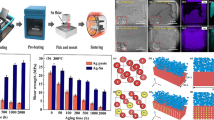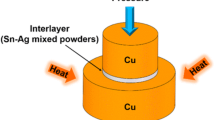Abstract
Low-temperature transient liquid phase (TLP) bonding is a very promising technology for achieving die attachment in high-temperature power devices. However, the Ag–Sn TLP-bonded joint has high sensitivity to shrinkage pores, which will lead to the deterioration of mechanical, thermal, and electrical properties. In this study, we have proposed two novel methods to solve the problem of pores in Ag–Sn TLP bonding through the introduction of second phases. The first method is replacing Ag substrate on one side with Cu substrate to create dual layers of dissimilar intermetallic compounds (IMCs). Consequently, the dual layers of Cu6Sn5 (or Cu3Sn) and Ag3Sn IMCs emerge on the cross-sections of bonded joint, resulting in the effective elimination of pores, which can be attributed to the change of the microstructure and the interface migration between two dissimilar IMC layers (e.g., Cu6Sn5/Ag3Sn). The second method is coating a thin Cu film on the Ag substrate to introduce Cu–Sn IMC particles. As a result, a great number of Cu6Sn5 particles disperse in the middle of the Ag3Sn layer, filling the micropores efficiently, such that a significant decrease in shrinkage pores is achieved. Both methods have been experimentally verified to improve the mechanical properties, and they have high potential to be implemented in other TLP systems.











Similar content being viewed by others
References
Manikam VR, Cheong KY (2002) Die attach materials for high temperature applications: a review. IEEE Trans Compon Packag Manuf Technol 1:457–478
Neudeck PG, Okojie RS, Chen L (2002) High-temperature electronics—a role for wide bandgap semiconductors. Proc IEEE 90:1065–1076
Cook GO, Sorensen CD (2011) Overview of transient liquid phase and partial transient liquid phase bonding. J Mater Sci 46:5305–5323. doi:10.1007/s10853-011-5561-1
Li JF, Agyakwa PA, Johnson CM (2011) Interfacial reaction in Cu/Sn/Cu system during the transient liquid phase soldering process. Acta Mater 59:1198–1211
Chu K, Sohn Y, Moon C (2015) A comparative study of Cn/Sn/Cu and Ni/Sn/Ni solder joints for low temperature stable transient liquid phase bonding. Scr Mater 109:113–117
Tollefsen TA, Larsson A, Løvvik OM, Aasmundtveit K (2012) Au-Sn SLID bonding—properties and possibilities. Metall Mater Trans B 43:397–405
Li JF, Agyakwa PA, Johnson CM (2010) Kinetics of Ag3Sn growth in Ag-Sn-Ag system during transient liquid phase soldering process. Acta Mater 58:3429–3443
Liu J, Kumar P, Dutta I, Raj R, Sidhu R, Renavikar M, Mahajan R (2011) Liquid phase sintered Cu–In composite solders for thermal interface material and interconnect applications. J Mater Sci 46:7012–7025. doi:10.1007/s10853-011-5670-x
Bosco NS, Zok FW (2004) Critical interlayer thickness for transient liquid phase bonding in the Cu-Sn system. Acta Mater 52:2965–2972
Wang PJ, Sha CH, Lee CC (2010) Silver microstructure control for fluxless bonding success using Ag-In system. IEEE Trans Compon Packag Technol 33:462–469
Lis A, Leinenbach C (2015) Effect of process and service conditions on TLP-bonded components with (Ag, Ni-)Sn interlayer combinations. J Electron Mater 44:4576–4588
Liu H, Wang K, Aasmundtveit KE, Hoivik N (2012) Intermetallic compound formation mechanisms for Cu-Sn solid-liquid interdiffusion bonding. J Electron Mater 41:2453–2462
Kim JY, Yu J (2008) Effects of residual impurities in electroplated Cu on the Kirkendall void formation during soldering. Appl Phys Lett 92:92109–92112
Yu C, Chen J, Cheng Z, Huang Y, Chen J, Xu J, Lu H (2016) Fine grained Cu film promoting Kirkendall voiding at Cu3Sn/Cu interface. J Alloy Compd 660:80–84
Yin L, Borgesen P (2011) On the root cause of Kirkendall voiding in Cu3Sn. J Mater Res 26:455–466
Kim SH, Yu J (2013) Heat-treatment to suppress the formation of Kirkendall voids in Sn-3.5Ag/Cu solder joints. Mater Lett 106:75–78
Chang Y, Hsieh Y, Chen K (2014) Submicron Cu/Sn bonding technology with transient Ni diffusion buffer layer for 3DIC application. IEEE Electron Device Lett 35:1118–1120
Chia PY, Haseeb ASMA (2015) Intermixing reactions in electrodeposited Cu/Sn and Cu/Ni/Sn multilayer interconnects during room temperature and high temperature aging. J Mater Sci 26:294–299. doi:10.1007/s10854-014-2398-9
Chidambaram V, Bangtao C, Lip GC, Woo DRM (2014) Au-In-based hermetic sealing for MEMS packaging for down-hole application. J Electron Mater 43:2498–2509
Chu K, Sohn Y, Moon C (2015) A comparative study of Cn/Sn/Cu and Ni/Sn/Ni solder joints for low temperature stable transient liquid phase bonding. Scr Mater 109:113–117
Shao H, Wu A, Bao Y, Zhao Y, Zou G (2016) Microstructure characterization and mechanical behavior for Ag3Sn joint produced by foil-based TLP bonding in air atmosphere. Mater Sci Eng A. doi:10.1016/j.msea.2016.10.092
Shao H, Wu A, Bao Y, Zhao Y, Zou G (2016) Interfacial reaction and mechanical properties for Cu/Sn/Ag system low temperature transient liquid phase bonding. J Mater Sci 27:4839–4848. doi:10.1007/s10854-016-4366-z
Yu H, Sun Y, Alpay SP, Aindow M (2016) Solidification microstructures in Ag3Sn–Cu3Sn pseudo-binary alloys. J Mater Sci 51:6474–6487. doi:10.1007/s10853-016-9947-y
Baker OH (1992) ASM handbook: alloy phase diagrams version 3. ASM International, Metals Park
Hang C, Tian Y, Zhang R, Yang D (2013) Phase transformation and grain orientation of Cu-Sn intermetallic compounds during low temperature bonding process. J Mater Sci 24:3905–3913. doi:10.1007/s10854-013-1337-5
Yuan Y, Guan Y, Li D, Moelans N (2016) Investigation of diffusion behavior in Cu-Sn solid state diffusion couples. J Alloy Compd 661:282–293
Ip SW, Toguri JM (1994) The equivalency of surface tension, surface energy and surface free energy. J Mater Sci 29:688–692. doi:10.1007/BF00445980
Upmanyu M, Smith RW, Srolovitz DJ (1998) Atomistic simulation of curvature driven grain boundary migration. Interface Sci 6:41–58
Farrer JK, Carter CB, Ravishankar N (2006) The effects of crystallography on grain-boundary migration in alumina. J Mater Sci 41:661–674. doi:10.1007/s10853-006-6482-2
Chuang HY, Yu JJ, Kuo MS, Tong HM, Kao CR (2012) Elimination of voids in reactions between Ni and Sn: a novel effect of silver. Scr Mater 66:171–174
Chang J, Chang T, Chuang T, Lee C (2014) dual-phase intermetallic interconnection structure and method of fabricating the same. US Patent US9742600B2
Dybkov VI (1998) Growth kinetics of chemical compound layers. Cambridge International Science, Cambridge
Yoon J, Jung S (2008) Effect of immersion Ag surface finish on interfacial reaction and mechanical reliability of Sn-3.5Ag-0.7Cu solder joint. J Alloy Compd 458:200–207
Gagliano RA, Ghosh G, Fine ME (2002) Nucleation kinetics of Cu6Sn5 by reaction of molten tin with a copper substrate. J Electron Mater 31:1195–1202
Liu AA, Kim HK, Tu KN, Totta PA (1996) Spalling of Cu6Sn5 spheroids in the soldering reaction of eutectic SnPb on Cr/Cu/Au thin films. J Appl Phys 80:2774–2780
Acknowledgements
This work was financially supported by the National Science Foundation of China under Grant No. 51375260, which is entitled ‘‘Technology and Mechanism of Low Temperature Transient Liquid Phase Bonding’’.
Author information
Authors and Affiliations
Corresponding author
Ethics declarations
Conflict of interest
The authors declare that they have no conflict of interest.
Rights and permissions
About this article
Cite this article
Shao, H., Wu, A., Bao, Y. et al. Elimination of pores in Ag–Sn TLP bonds by the introduction of dissimilar intermetallic phases. J Mater Sci 52, 3508–3519 (2017). https://doi.org/10.1007/s10853-016-0645-6
Received:
Accepted:
Published:
Issue Date:
DOI: https://doi.org/10.1007/s10853-016-0645-6




